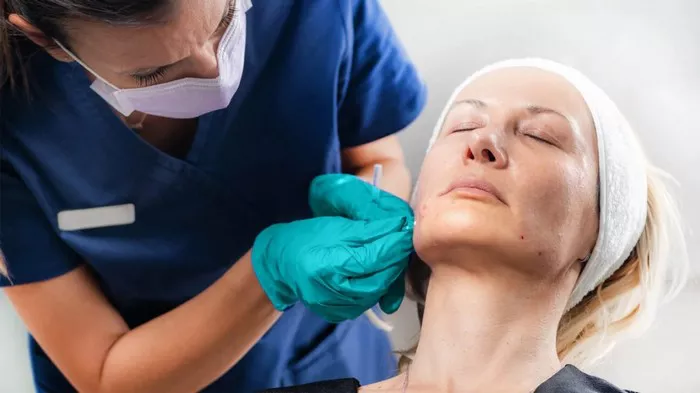Facial threading is a popular method of hair removal and shaping that originated in the Middle East and South Asia. It involves the use of a thin thread, typically made of cotton or polyester, to remove unwanted facial hair from areas such as the eyebrows, upper lip, and chin. In recent years, threading has gained popularity worldwide due to its precise and long-lasting results. In this article, we will explore how threading works on the face, its benefits, and considerations for those interested in trying this technique.
Understanding the Process of Facial Threading
Facial threading is a technique that involves using a twisted thread to remove unwanted hair from the root. Here’s how the process typically unfolds:
Preparation: The threading specialist will cleanse the skin and prepare it for the procedure. This step may involve wiping the area with a gentle cleanser or applying a soothing lotion to minimize discomfort.
Thread Selection: The threading specialist will select a piece of thread that is suitable for the specific area being treated. The thread is typically doubled and twisted to create a loop with a twisted section in the middle.
Hair Removal: The specialist will hold one end of the twisted thread in their mouth and use their hands to manipulate the looped section. By opening and closing their hand, they create a twisting motion that moves along the hairline or targeted area. As the thread moves, the twisted section catches and lifts the unwanted hair, pulling it from the root.
Repeat Process: The threading process is repeated until the desired area is clear of unwanted hair. The specialist will carefully maneuver the thread to precisely remove hair in a smooth and efficient manner.
Post-Treatment: Once the threading is complete, the specialist may apply a soothing lotion or gel to calm the skin and reduce any redness or sensitivity caused by the procedure.
Benefits of Facial Threading
Facial threading offers several advantages over other hair removal methods. Here are some of the benefits associated with this technique:
Precise Hair Removal
Threading allows for precise control, enabling the specialist to target individual hairs and shape the eyebrows or remove unwanted facial hair with accuracy. This level of precision is particularly beneficial for achieving well-defined eyebrow arches.
Minimal Skin Irritation
Compared to other hair removal methods such as waxing or depilatory creams, threading generally causes less irritation to the skin. The threading thread does not come into direct contact with the skin, reducing the risk of allergic reactions or skin sensitivity.
Long-Lasting Results
Threading removes hair from the root, resulting in slower and finer regrowth compared to shaving or using depilatory creams. This can lead to longer-lasting results, with hair taking longer to grow back and appearing softer and finer when it does.
Suitable for Sensitive Skin
Individuals with sensitive skin often find threading to be a more comfortable and tolerable hair removal method. The gentle nature of threading minimizes the risk of skin irritation, making it a suitable option for those prone to redness or sensitivity.
Natural Look
Threading allows for precise hair removal while maintaining a natural appearance. Unlike waxing, which can remove a layer of skin cells along with the hair, threading solely focuses on the unwanted hair, preserving the natural texture and tone of the skin.
Considerations and Tips for Facial Threading
Before opting for facial threading, consider the following tips and precautions:
Find an Experienced Specialist: Threading requires skill and precision. It is essential to find a reputable and experienced threading specialist who is knowledgeable about the technique and understands your desired outcome.
Communicate Your Preferences: Clearly communicate your expectations and desired shape when threading your eyebrows. Providing a reference or discussing the desired thickness and arch can help the specialist achieve your desired results.
Exfoliate and Moisturize: Prior to threading, exfoliate the skin to remove dead skin cells and ensure a smoother hair removal process. Additionally, moisturize the treated area afterward to keep the skin hydrated and minimize any potential dryness or irritation.
Avoid Sun Exposure and Harsh Products: After threading, avoid direct sun exposure and harsh skincare products for a day or two. The skin may be more sensitive immediately after the procedure, and these precautions can help minimize any potential adverse reactions.
Maintain Regular Threading Sessions: To maintain a well-groomed appearance, consider scheduling regular threading sessions to keep unwanted hair at bay. The frequency of threading sessions can vary depending on individual hair growth patterns.
Conclusion
Facial threading is a popular hair removal technique known for its precision, long-lasting results, and minimal skin irritation. By utilizing a twisted thread, unwanted hair is removed from the root, allowing for precise shaping and hair removal in areas such as the eyebrows, upper lip, and chin. With its numerous benefits, including precise hair removal, minimal skin irritation, and a natural look, facial threading has become a preferred choice for many individuals seeking effective hair removal and shaping. To ensure a successful threading experience, find an experienced specialist, communicate your preferences, and follow post-treatment care guidelines. Enjoy the benefits of facial threading and embrace a well-groomed and defined appearance.

